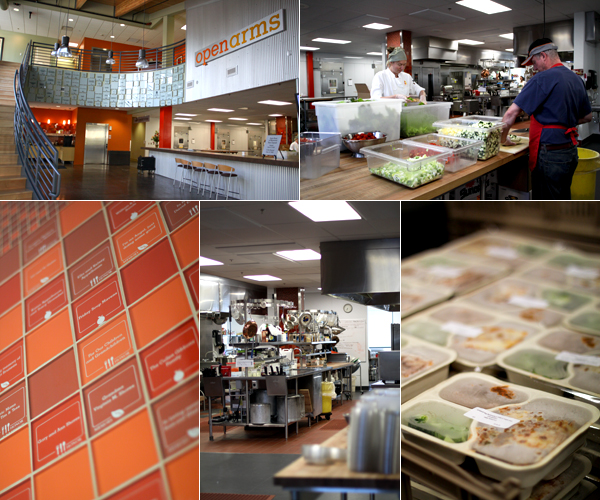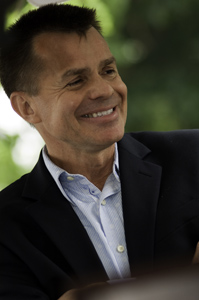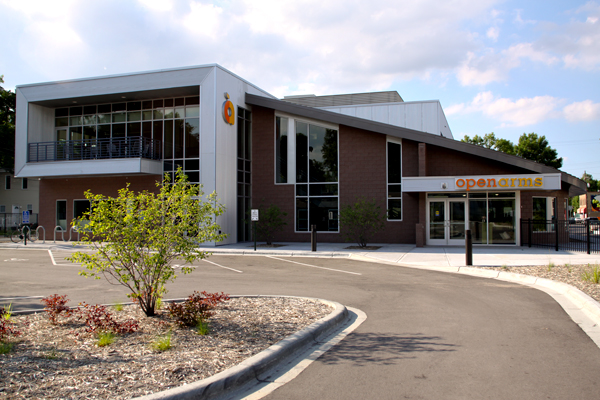
Earlier this month, we had the pleasure to attend an event celebrating a number of milestones for Open Arms of Minnesota, a Minneapolis non-profit that prepares and delivers free meals to people with serious and life-threatening diseases — including HIV, cancer, ALS, and MS.
It was a wet day, and a rather cold one for June. Yet we found ourselves in a tent with 350 or so of the non-profit’s volunteers, donors, clients, staff, and friends, cheerfully gnawing on barbecue ribs and alternately laughing and crying as guests took the podium to talk about Open Arms. Among them, Minneapolis Mayor R.T. Rybak, who opined: “Compassion is a growth industry.”
Looking at what Open Arms has achieved this year, it seems true. The non-profit recently delivered its two millionth meal, opened a brand new building in Minneapolis’ Phillips neighborhood, and started its own 2-acre organic garden in Belle Plaine, a project called Open Farms. Many of these things were possible because Open Arms had also successfully completed a stunning $8.1 million capital campaign in 2009. And all of this, let us not forget, in the middle of a recession.
With only 20 paid employees, Open Arms depends on volunteers: Last year, 1,400 volunteers worked 34,950 hours. Touring the new building, we were struck by how emotional, how genuinely joyful folks were in their reactions to the building. It was as if they had personally just gained a million dollar kitchen. One woman, a longtime volunteer, wandered out of a cooler full of packed, insulated delivery bags with her hand on her chest, saying “Oh, it makes me cry.”
The new kitchen is a bit overwhelming, essentially taking Open Arms from a six-burner stove to a state-of-the-art production kitchen that includes, among other things, a full bakery; giant 40-gallon soup kettles; a blast chiller, critical in preparing food for immune-compromised clients; and a monumental amount of freezer and cooler space (including a cooler specifically designated for produce donations; yet another use for your CSA box leftovers!).

So how has Open Arms sustained the generosity and, for lack of a better way to express it, the sense of ownership — or perhaps responsibility — among its community of volunteers and donors, growing even during a foul economy, a time when many for-profit organizations are falling by the wayside?

Here Kevin Winge (left), the non-profit’s executive director, talks about that, what all these milestones mean to the organization and its mission, and the importance of fun.
Let’s start with the building — what will this space mean for Open Arms?
I don’t know if I said it on Saturday, but I personally never wanted to do a capital campaign in my career, and the building itself was never the goal, but the work that we do happens to need a really large kitchen to do it, so the building was a means to an end.
At one point, in the old building, we thought we could never serve more than 200 clients. Then we changed the hours that we worked, added more volunteers to deliver, and by the time we left the building, we were actually serving 600 clients a week. But that was the capacity — we didn’t have the freezer space to do any more. The new building allows us — or the goal has been — to be able to serve as many people with chronic and progressive illnesses as need our services. I know that we haven’t even begun to tap into those needs yet.
Do you have a sense of how many people you’ll be able to serve in the new building?
I don’t think any of us knows what that capacity is. I believe we’ve got the physical structure — with enough coolers and freezers and everything else — to double the number of meals pretty easily. So this year we’ll do 350,000 meals; I think the structure will allow us to do 700, 000 meals. We’ll have to be creative to do that, obviously.
And by that, I mean, right now we just do deliveries Monday through Friday. If not this year, then certainly by next year, I want to pilot weekend deliveries. That would allow us to provide volunteer opportunities for families, which we don’t have now, and faith communities. Also, we’ve now got this beautiful facility that operates weekdays 7:30 in the morning to 9:30 at night. But what about that 10 pm to 6 am shift? We’ve got this great kitchen, I think we’ve got a responsibility to try to utilize it 24 hours a day if possible. It’s totally untapped what we’ll be able to do over the next few years.

The staff and the board have been talking about this since we launched the campaign. In that small building, we were forced to be creative because we didn’t have the space or the equipment to do a lot. Now, we’ve got this beautiful kitchen and we’ve got more space than we’ll need for many years, so how do we keep that sense of creativity? We’ve got a really creative staff, so I’m not really worried, but I think if we’re not conscious about it, we might get lazy…
On the subject of creativity, your capital campaign came at a time when you’d think people would be tighter with their time and money, yet it was incredibly successful. How were you able to do that?
A number of things came into play. One, we were far enough along in the capital campaign that we couldn’t quit. We had these matching grants so, if we weren’t successful, we would have lost $1.2 million. I know it’s really trite, but failure absolutely was not an option — even though some days I kind of hoped it would have been.
It certainly felt like we were addressing one of the most basic — if not the most basic — needs. When the economy went south, I think basic needs came to the forefront of a lot of people’s thinking.
I’ve said this to a lot of friends who work in non-profit arts: “You’ve got the harder job, trying to make a case for, say, opera in recession versus feeding people who are sick.” Also, a number of people made it through the recession untouched and, fortunately, some of them thought they had a greater responsibility to do more. And a number of people who were touched, who either had a family member unemployed or were themselves, continued to give because they saw just how fragile their own family turned out to be and, suddenly, they could imagine losing a job and also being sick.
The other piece is just plain old hard work — we knew it was going to be difficult and so we just kept at it.
One thing we really noticed at the event was the amount of personal pride everyone at the event on Saturday had for the building, volunteers, donors, friends…
We are incredibly relationship based. I actually love raising money for Open Arms, but I tell the staff who works with us on fundraising, don’t concentrate on the money, concentrate on the relationship — if we are doing our job with the relationship, the money will come. Most of the solicitation letters we send out don’t ask for a donation, we just include an envelope. People aren’t stupid. We don’t have say, “Thank you for your gift of $20; will you give us $40 this year?” People will give us what they can afford.

When I give tours, I say, “Welcome to your building.'” I want them to feel like it’s their program, their building, but I also want them to share the responsibility; if it’s important to us that we live in community where people who are sick don’t go hungry, we all have to share in it.
So it’s about more than meals, it’s about changing the world and transforming people’s lives. I think so many of us are disappointed and disenfranchised by some of the things that have been happening in this country for 10 years. At Open Arms we’re saying, it doesn’t have to be that way. If we don’t like our community they way it is, what can we do to change that?
Tell me about the Open Farms project…
The Prairie Oaks Institute called us and said, “We have two acres of land that we’re turning organic. If we gave you the use of this land, what would you want to do with it and how would it propel our mission?” And their mission is all about sustainability and being respectful of the Earth.
So part of it was that there was an opportunity, but the opportunity, in my mind, is less about the produce that we’re eventually going to be able to harvest, because that will cost us more in the short term than to just purchase really healthy ingredients from the farmers directly. What gets me excited about the Open Farms project is the teachable moment; it’s another opportunity to involve our stakeholders and to start to encourage conversations about where our food comes from and what it means to actually plant and grow. A lot of the people at Open Arms, even though they are foodies, have no idea what a real farm is like and how food grows.
Eventually, it may not be this year or next year, but the plan is that we start to bring school kids, both from the Belle Plaine area and the Twin Cities, to the farm to help weed and water and all of those things.
That’s a great idea: It’ll be fun, they’ll learn something about where food comes from, but you’ll also start teaching them the value of serving your community.
What I really love about the way Open Arms works is that we never hit anyone over the head. I mean, you won’t see anywhere in our communications that we want to affect how people vote, how they spend their money, how they spend their time, or what kinds of foods they put in their body, but that’s exactly what we are trying to impact. You don’t have to harp on it, you bring people together and it’s a much more contemplative approach.

We introduce things like healthy eating, the farm project, and the work we do in South Africa… You know, someone who delivers food for Open Arms, even if they think there is no poverty in the Twin Cities, we’ll send them to places most of the drivers have been fortunate enough to not see, and people come back time and again and say, “We had no idea that some people live the way they do in the Twin Cities.” Now we have them. We didn’t have to do a presentation on poverty in the Twin Cities; they saw it for themselves, and if they start to think about it, then we’ll see change.
How will all the new kitchen equipment help you serve your clients better — obviously, it’s bigger, but what are the other factors?
Yes, the biggest two factors are just space to prepare and serve more meals and food safety.
So when I talk about food safety, there’s really two components. All of our clients have compromised immune systems. Prior to the new building, we had one walk-in cooler upstairs and one walk-in cooler in the basement, so when the meals were packed in the morning, they would be on the tables upstairs waiting for the driver to come in and sometimes it could be three and a half hours that the insulated packs could be waiting. Now they get wheeled back into the cooler where they stay until the driver arrives.
Then there’s the safety of staff and volunteers. Commercial kitchens are dangerous places. Prior to the new building, all the soup was made in five-gallon pots, so we’d have six pots simmering at the same time with volunteers having to stand on milk crates to be high enough to lift them off the stove. Now we have 40-gallon soup kettles that tip. You know, I can’t believe we made it through the old building without a volunteer falling when they were taking those pots of boiling soup off the stove and burning themselves — that’s as close to a miracle as we ever had.
And then it’s just having enough free storage, between the coolers and the freezers. That was the issue in the old building. Three years ago, we realized we didn’t have space to do the Thanksgiving meal. No one on staff said, “We don’t have enough space, so we’re only going to feed 300 people.” They just started calling around, finding out what a freezer would cost. Finally, one of the cooks said, “What if we put a freezer truck in parking lot for the two weeks around Thanksgiving?” So that’s how we did it the last couple of years.
What does the 2 millionth meal milestone mean to you?
To me, it just shows how long we’ve been around. The fact that our founder Bille Rowe decided to address a need in the AIDS community 24 years ago, at a time when so many people wanted nothing to do with HIV and AIDS, is pretty phenomenal. My whole motivation for doing this work comes from all the people I knew who died early on in the AIDS epidemic. For me, a lot of this work has been around just trying to make something good come out of HIV and AIDS, so to announce 2 million meals makes up for some of the really bad times in the ’80s and ’90s.
If we can do two million meals, a lot of those in bad economy, most of those meals with no one in town ever having heard of us, just imagine what we can do if more people are aware of what we are trying to do?

But one thing I always forget to talk about is that we are also all about having fun. The lesson I learned early on in the AIDS epidemic in this country is — you better celebrate life because there is a real down side to all of this. Earlier in my life, I was volunteered for some AIDS organizations. I’d walk in and it would just be gloom and doom. That’s not what I needed at that time and I don’t think that’s what volunteers needed. I think they needed to go somewhere not only where they were appreciated, but also where they could make a difference.
So we take our work seriously but we also value fun, and that’s the other thing that keeps Open Arms going. You can have fun at work and you can have fun where you volunteer and you damn well better be celebrating life because, for so many people that we work with, that’s coming to an end. Oh now, even our conversation on fun, I’m sounding serious!
No, but I get it. I saw that at the event on Saturday. There’s a real joy to being involved with Open Arms; you leave feeling inspired, happy, and a little empowered.
One of the things that is so frustrating to me is that people don’t understand that you can celebrate and be joyful and still be completely cognizant of all the challenging things in the world. Years ago, a reporter said that Open Arms is a bunch of naïve Pollyannas trying to change the world. We are not Pollyannas, but we are trying to change the world.
We know what the world is like, for good and bad, and we choose to try to create a different kind of way to do our work and live in the community — and that’s not naïve, that’s a conscious choice.

Thank you so much for publishing this very important article, what a wonderful organization…truly inspiring!
Since its inception, Open Arms has been a true gift. It’s nothing but pure love and kindness.
It is exactly because of these “naive Pollyannas trying to change the world” and the inspired leadership of Kevin and the entire Open Arms staff that hundreds of people across the Twin Cities are being fed every day, and why hundreds more choose to volunteer to help accomplish this goal. Great article – on an important issue and amazing organization.
This is truly one of the greatest gifts that have come out of such a tragic situation (HIV/AIDS). Kevin you are a wonderful leader, plus the staff you have around you deserve all the admiration we as a City, State and Country can muster. It gives me great pride to contribute to this organization in any manner that I can. Thank you.